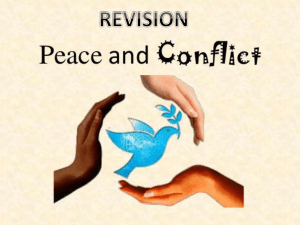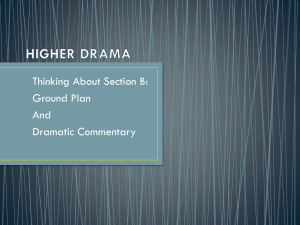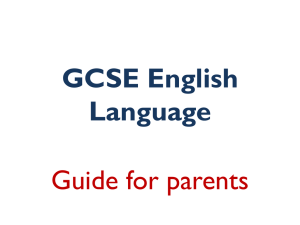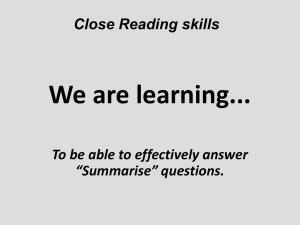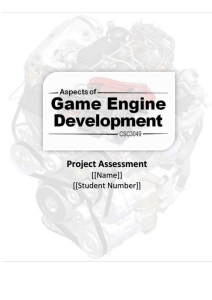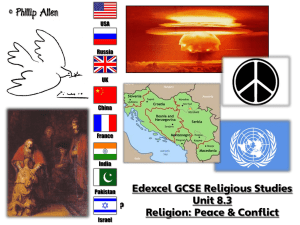Revision Map
advertisement
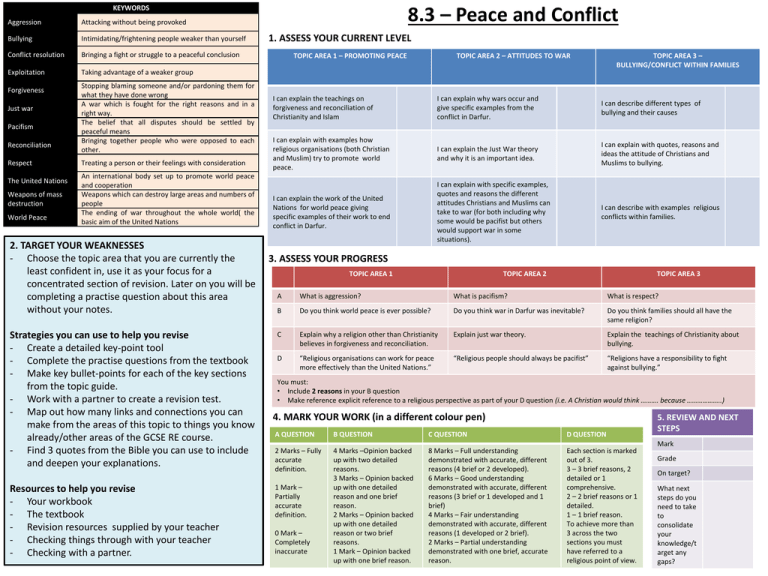
KEYWORDS Aggression Attacking without being provoked Bullying Intimidating/frightening people weaker than yourself Conflict resolution Bringing a fight or struggle to a peaceful conclusion Exploitation Taking advantage of a weaker group Forgiveness Just war Pacifism Reconciliation Respect The United Nations Weapons of mass destruction World Peace Stopping blaming someone and/or pardoning them for what they have done wrong A war which is fought for the right reasons and in a right way. The belief that all disputes should be settled by peaceful means Bringing together people who were opposed to each other. Treating a person or their feelings with consideration An international body set up to promote world peace and cooperation Weapons which can destroy large areas and numbers of people The ending of war throughout the whole world( the basic aim of the United Nations 2. TARGET YOUR WEAKNESSES - Choose the topic area that you are currently the least confident in, use it as your focus for a concentrated section of revision. Later on you will be completing a practise question about this area without your notes. Strategies you can use to help you revise - Create a detailed key-point tool - Complete the practise questions from the textbook - Make key bullet-points for each of the key sections from the topic guide. - Work with a partner to create a revision test. - Map out how many links and connections you can make from the areas of this topic to things you know already/other areas of the GCSE RE course. - Find 3 quotes from the Bible you can use to include and deepen your explanations. Resources to help you revise - Your workbook - The textbook - Revision resources supplied by your teacher - Checking things through with your teacher - Checking with a partner. 8.3 – Peace and Conflict 1. ASSESS YOUR CURRENT LEVEL TOPIC AREA 1 – PROMOTING PEACE TOPIC AREA 2 – ATTITUDES TO WAR TOPIC AREA 3 – BULLYING/CONFLICT WITHIN FAMILIES I can explain the teachings on forgiveness and reconciliation of Christianity and Islam I can explain why wars occur and give specific examples from the conflict in Darfur. I can describe different types of bullying and their causes I can explain with examples how religious organisations (both Christian and Muslim) try to promote world peace. I can explain the Just War theory and why it is an important idea. I can explain with quotes, reasons and ideas the attitude of Christians and Muslims to bullying. I can explain the work of the United Nations for world peace giving specific examples of their work to end conflict in Darfur. I can explain with specific examples, quotes and reasons the different attitudes Christians and Muslims can take to war (for both including why some would be pacifist but others would support war in some situations). I can describe with examples religious conflicts within families. 3. ASSESS YOUR PROGRESS TOPIC AREA 1 TOPIC AREA 2 TOPIC AREA 3 A What is aggression? What is pacifism? What is respect? B Do you think world peace is ever possible? Do you think war in Darfur was inevitable? Do you think families should all have the same religion? C Explain why a religion other than Christianity believes in forgiveness and reconciliation. Explain just war theory. Explain the teachings of Christianity about bullying. D “Religious organisations can work for peace more effectively than the United Nations.” “Religious people should always be pacifist” “Religions have a responsibility to fight against bullying.” You must: • Include 2 reasons in your B question • Make reference explicit reference to a religious perspective as part of your D question (i.e. A Christian would think ………. because ………………..) 4. MARK YOUR WORK (in a different colour pen) A QUESTION B QUESTION C QUESTION D QUESTION 2 Marks – Fully accurate definition. 4 Marks –Opinion backed up with two detailed reasons. 3 Marks – Opinion backed up with one detailed reason and one brief reason. 2 Marks – Opinion backed up with one detailed reason or two brief reasons. 1 Mark – Opinion backed up with one brief reason. 8 Marks – Full understanding demonstrated with accurate, different reasons (4 brief or 2 developed). 6 Marks – Good understanding demonstrated with accurate, different reasons (3 brief or 1 developed and 1 brief) 4 Marks – Fair understanding demonstrated with accurate, different reasons (1 developed or 2 brief). 2 Marks – Partial understanding demonstrated with one brief, accurate reason. Each section is marked out of 3. 3 – 3 brief reasons, 2 detailed or 1 comprehensive. 2 – 2 brief reasons or 1 detailed. 1 – 1 brief reason. To achieve more than 3 across the two sections you must have referred to a religious point of view. 1 Mark – Partially accurate definition. 0 Mark – Completely inaccurate 5. REVIEW AND NEXT STEPS Mark Grade On target? What next steps do you need to take to consolidate your knowledge/t arget any gaps?
